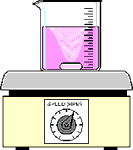4. Why is diffusion through a membrane faster sometimes?

Revisit the osmoregulation portion of the Fire & Ice Scenario. We talked about passage of salt and water through a nephron loop. Look at Chapter 35 Regulation of Temperature and Body Fluids in your text book. How does a kidney work? You may also have to look in the textbook for some of the terms listed below. Chapter 2 on the Chemistry of Life will help you understand ions and something about the relative size of different molecules. the chapter on Cellular (Chapter 3) and The Energy of life (Chapter 4) discusses membranes and movement of molecules through a membrane. The CD-ROM has information and video-clips showing molecular movments. The Osmosis and Diffusion tutorial for the Pre-lab will give you a peek at the impact of placing cells or organisms in a solution with a different concentration of solutes than inside the organism. Do you know why the bags swell or shrink? It might help you plan this lab. Does this type of movement require a living organism to expend energy? Hmmmm. What powers the movement of the atoms, ions, molecules? How about the Dialysis Animation we put on the WWW - Does it give you an "image" of what is happening? In Out of the Rainforest, we examine membranes for the first time and look at the passage of substances through them. Is this similar to the nephron loop? We will look at membranes and the passage of substances in some future scenarios as well. Be sure to note them when we do.
| Concentration Gradient | Isotonic |
| Dialysis | Molecule |
| Diffusion | Osmosis |
| Gradient | Selectively permeable |
| Hypertonic | Solute |
| Hypotonic | Solution |
| Ion | Solvent |
